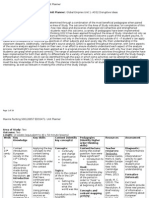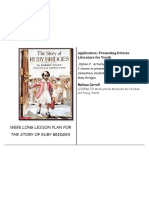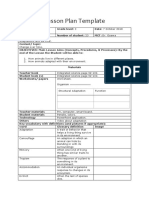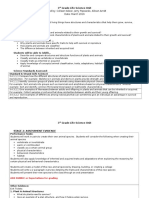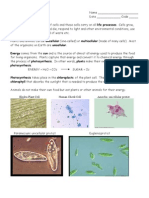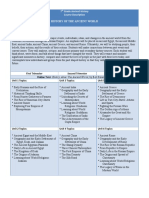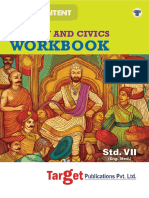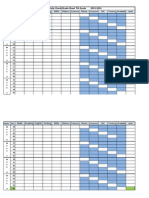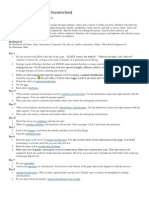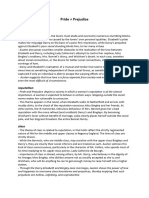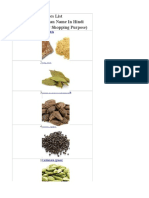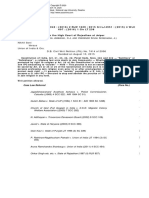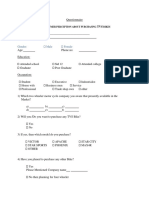Biology Science
Biology Science
Uploaded by
Kristine J McAdams LancasterCopyright
Available Formats
Share this document
Did you find this document useful?
Is this content inappropriate?
Report this DocumentCopyright:
Available Formats
Biology Science
Biology Science
Uploaded by
Kristine J McAdams LancasterCopyright:
Available Formats
Easy Peasy All in One Homeschool
BIOLOGY
Course Description: Students will explore two branches of biology: human anatomy and plant life. Students will learn about the body systems and conduct experiments to further their understanding. A study of plants will include their structure, reproduction, and types. Soil, biomes and underwater plants are some of the special topics covered. Students will use textbooks, videos and online learning materials. Experiments and nature observations will enhance their learning and understanding. Students will have the opportunity to present their experimental findings to an audience. Reading List: (selections of the following titles) M Real Things in Nature, Holden; Life Science for Middle School, Wilkin Day 1 I want to teach you something about science. Science is a collection of observations about the world. When something has been observed enough, it becomes scientific law. That means that scientists say that what they have observed will always be true. It is stated as fact. But even these laws have been broken at times when all of a sudden, something different is observed. It was believed that the atom was the smallest thing in the universe. It was called fact. Then someone split it open and found protons and electrons. The point is that science only really tells us what has been observed. It doesnt prove truth. It just states what is ob served and measured in the world around us. Why am I making sure you understand this? Because who was there to observe the creation of the universe? God alone. Science c ant prove anything about the creation of the world because it can make no observations about it. It takes what it observes in the world today and makes hypotheses, guesses, about the creation of the world. Until pretty recently most Western scientists were Christians. Never let anyone make you feel stupid for believing God created the world. Albert Einstein believed in God as creator, and he was one of the smartest scientists to have ever lived. The Bible contains all truth. You never have to be afraid to believe the truth in the Bible. There may seem to be things that couldnt possibly be true. Say, we measure stars at being billions of light years away. That means, in order for us to see its light, that light would have had to be traveling for billions of years to reach us. Well, a Christian mathematician and scientist has shown how it could appear that way and still only be less than ten thousand years away. No one has yet been able to dispute the math he used to show it. Heres an article about it that your parents might be interested in. One method science uses to try and observe somethings age is carbon dating. There are some that say carbon dating shows that there are bones that are millions of years old. Here are two articles that talk about how carbon dating isnt accurate. These are articles for adults. You dont have to read them. The first is much easier to read than the second, but if you or your parents are interested, please go ahead and read them. I just want to show you that there are scientists that believe the earth is young. I personally know a scientist, a physicist with a PhD, who has studied the topic and believes the earth to be less than 10,000 years old. Its not silly to be lieve it. It is silly to let someone change your mind with facts that arent proven true. Remember this: Scientist dont agree on things! Anytime you hear someone say, All scientists say that It isnt true. Its propaganda to try and get you to believe something. Dont be afraid to believe the Bible. It will always prove to be true in the end. God is Truth and cannot lie! You can trust His Word. 1. Explain to someone what science is and why it cant tell us what happened at the beginning of time.
Day 2 1. Read the first chapter on Characteristics of Living Organisms. Before you can use this site, you will need to register. Ask a parent to help you create a username and password. This is a site where you can use your junk email and password. Make sure you tell the site to remember you. 2. You may click on the link to watch the vimeo video on the introduction to life. The cell video link does not work, though. Answer the review questions 1-5. Thats where you stop reading. 3. STUDY TIP: Go to the end and read the questions first. That way you can be looking for the answers while you read. It will make it easier for you if you will just take an extra minute to look at the questions before the reading.
4. Check your answers when you are done, answers Life Science, click on 2.1 . Human Body, first up is skin Day 3 1. Well learn about cells later, but you should remember that everything in your body is made up of cells. Each cell is about 7 0% water so what atoms do you know are present in your cells? (answer: hydrogen and oxygen H20) 2. Read about skin. Click on The Integumentary System.
3. 4. 5. 6.
Answer review questions 1-7. If I dont have a check answers link, its because they dont have the answers for that chapter yet. Watch this skin lesson. What makes skin an organ?
7. Look at these images of skin and make observations. Day 4 1. Label the skin. Heres the image from your reading on day 3. Muscular System Day 5 1. Read the section on The Muscular System. 2. Answer review questions 1-6. Day 6 1. Play poke a muscle. (Have a parent load the page. Refresh if the ads arent good.) Click on scan. Read the names of the muscles. Click on begin. Use the scanner to find the muscle named; it will be a different color. Click on it. Repeat until you can click on all of the muscles. 2. Do the jigsaw puzzle if you want to. (Have a parent load the page and decide about the ads.) Skeletal System Day 7 1. Read about the Skeletal System. 2. Answer the review questions Day 8 1. Take the tour of the skeletal system by clicking on English and then Skeleton and then Bones Narrated. 2. Then click on Build a Skeleton. Day 9 (Materials for L: 6 pieces of paper, tape, paper plate or lightweight plastic plate, wooden blocks or something to add as weight) 1. Watch this video on bone structure. Then take the quiz. 2. Look at this skeleton. 3. *Print and label this skeleton. Day 10 1. Concentration 2. Take the test! 3. One more test! 4. Perform knee surgery if you want to. Digestive System Day 11 1. Read the Food and Nutrients chapter. 2. Stop at the review questions and answer them. Day 12 1. Read the Digestive System chapter. 2. Answer the review questions. Day 13 1. *Label the digestive system. 2. Can you fill out the crossword puzzle? Day 14 (paper towel, bowl of water) 1. Take a nutrition quiz. 2. Take a digestion quiz. 3. Report your scores to your parents. Day 15 1. Take a test. 2. One more! 3. Report your scores to your parents. Day 16
1.
Write the story of a doughnut being eaten and digested. You can write it as the doughnut speaking. OR, draw a diagram of its route and add labels telling what happens at each point.
Day 17 (Materials for L: 4 glasses or jars or test tubes, 4 pieces of hard candy, water, hammer? need to smash some candies) 1. Watch the video and take the quiz. Day 18 1. Take the Skin Quiz. 2. *Do the skin word find. Day 19 1. Muscular System Quiz 2. *What do you know? Fill in the muscles. Day 20 1. Skeletal System Quiz 2. Can you put the skeleton together? Circulatory System Day 21 1. Watch this movie on circulation. 2. Then take the quiz. Day 22 1. Watch a movie on circulation. 2. Take the quiz. Day 23 1. Read this article on the heart. 2. Read through all the pages. 3. Take your pulse resting and then after running around. Compare the two. Record them. Day 24 1. Watch the video. 2. *Print out and label the heart. Day 25 1. Read the section on Blood. Its the third section. 2. Answer the questions at the end of the section. Day 26 1. Complete the crossword puzzle. Day 27 1. Read the Introduction to the Cardiovascular System. 2. Answer the questions. Day 28 1. Quiz time. 2. Test time. 3. Make sure you check your answers and go back and look at what you got wrong and learn the right answer. Day 29 (Materials for L: dime-size piece of clay, toothpick; maybe a few pieces of electrical tape could replace the clay) 1. Quiz time. 2. Quiz again. 3. Make sure you check your answers and go back and look at what you got wrong and learn the right answer. Day 30 1. Print page 5, the human body outline. Fill in as much as you can. Draw lines and labels. Respiratory System Day 31 1. Read the first section of this chapter on the respiratory system. Answer the review questions. Day 32 (Materials for L and M: 2 twelve inch (30 cm.) balloons, plastic water bottle not flimsy, needs some strength, 20 oz. to 1 liter in size I would suggest) 1. Do this inhalation sequence activity. 2. Build a model of the lungs. Watch the video. (You can do this together with an L student.) 1. Demonstrate your model and explain it.
Day 33 1. Watch the movie and take the quiz. 2. *Label the lungs. Day 34 1. Take the quiz. 2. Learn how vocal sounds are produced. Interested? Click here for more. Day 35 1. Your choice: Perform heart surgery with stem cells. Repair an artery. Build a skeleton. Poke a muscle. Watch out for ads on this site. Excretory System Day 36 1. Read the section on the Excretory System. Its the third section. 2. Answer the review questions. Day 37* 1. Complete the test. 2. Can you complete the crossword puzzle? Nervous System Day 38 1. Read this article. Click through and read all five pages. 2. Then you can watch this movie. Day 39 1. Today read the first section in this chapter on the nervous system. 2. Stop at the review questions and answer them. Day 40 1. Take the tour of the brain. Click on all the different parts and listen and read everything. 2. *Can you fill in the blanks on this nerve picture? If you need help, see the chapter you read on day 40. Day 41 1. You dont have to read this whole thing, but look carefully at all of the diagrams of the brain. 2. *Here are two brains (one two) to print out and to label. Day 42 1. *Make a brain hat. (You can decide if everyone is going to have his or her own hat or if you will share one.) 2. Study your hat. 3. Have someone quiz you where you do different things, like speech, and you try and point to that part on your brain. Day 43 1. Complete the crossword puzzle. You can click on word list at any time to help you figure it out. 2. Take the quiz. If you get something wrong, learn from it. You havent read the book these questions are from, so its okay to get something wrong, but learn from your mistake! Day 44 (Materials for M: 10 matching pairs from a deck of cards or other game) 1. Read about memory. Click to turn the page until the article is finished. 2. *Try this memory experiment. Read page 8. Print page 9. Day 45 1. Brain gamestest your brainwhat an amazing thing your brain is! stoplight hit the dot short term memory face recognition brain maze Are you smarter than a chimp? 1. Perform brain surgery if you like. You can just use the animated section, or if you have a strong stomach, there are real pictures. Senses
Day 46 1. Read about eyes and vision. 2. Answer the review questions #1-6. Day 47 1. Learn about eye anatomy. 2. If you can stomach it, you can watch a cows eye dissection . 3. Do this experiment with a paper towel tube. 4. If you really cant do the experiment, then can you do this one, peripheral vision, or read about this one, upside down. 5. Explain to someone how the experiment worked and what the conclusion, result, of the experiment was. Day 48 1. Read the Other Senses section and answer the questions. Day 49 1. Design and carry out an experiment using taste and smell to answer the question, Can You Identify Food Only with Taste or Only with Smell? 2. Write up an experiment worksheet. Day 50 1. Learn about how hearing works. 2. Do this activity comparing human and animal hearing. 3. At the dinner table tell what you learned on the subject. Day 51 1. Learn more about taste. Do both tabs. 2. Take a smell quiz. Day 52 1. Take the tongue quiz. 2. Take the nose quiz. 3. Take the ear quiz. 4. Learn from your mistakes. Day 53 1. Take the senses quiz. 2. Take the test. 3. Here are some quick sense experiments to try. One or two Saliva Pencil bump Flag Day 54 1. Complete the crossword puzzle. 2. If you want to try some more experiments, scroll down to the five senses. 3. Whether you do the experiments or not, explain to someone about the experiments you did today and yesterday and what they show about our senses. Day 55 1. Make a list. List each of the body systems weve learned about and list as many parts as you can in each. 2. Afterwards, take a look through this tutorial and see what you forgot. Reproductive System M Day 56 1. Read about the male reproductive system and answer the questions. Day 57 1. Read about the female reproductive system and answer the questions. Cells Day 58 1. Watch this stages of birth video and take the quiz. 2. Watch this video and click on the links to learn about the development of a baby, of you from the beginning! 3. Psalm 139:13-14
Day 59 1. Watch this lesson on the endocrine system. 2. Put the pieces in the body. You just have to get close and it will pop it into place. Day 60 1. Read the Introduction to cells and answer the questions. 2. The video on The Inner Life of the Cell isnt working, but I found a working version. You can wat ch ithere. Day 61 1. Read the second half of the chapter on cell structure and answer the questions. 2. Check your answers when you are done, answers Life Science, page 58. Day 62 1. Read the first section on Transport watch the videos. Answer the questions. Day 63 1. Read the last section on Cellular Respiration. Watch the videos. Answer the review questions. Day 64 1. Read the first section on Cell Division . Use the videos. Answer the questions. Tonight you might want to make tomorrows project. 2. Check your answers when you are done, answers Life Science, page 68. Day 65 (Materials for M: light-colored Jello or some gelatin grapes, mandarin oranges, plums or you could use raisins, candy, etc.3 different things) Or everyone could just work together on one model 1. Do the activity on pages 3-5. Make cells. Then draw one and label it. Day 66 1. Read about Mendel and the Foundation of Genetics. 2. Answer the review questions. Day 67 1. Complete this lesson on genetics and Punnett Squares. Day 68 1. Read about genetic advances and answer the questions. Day 69 1. Read about Bacteria and answer the questions. Day 70 1. Read about Archaea and answer the questions. Immune System Day 71 1. Read about infectious disease and answer the questions. Day 72 1. Read about noninfectious diseases and answer the questions. Day 73 1. Read about your bodys defenses and answer the questions. Day 74 (Materials for L: Q-tips, raw meat, beef bouillon, unflavored gelatin, sealable plastic baggies, antibacterial soaps, lotions, etc., it says 4 foil muffin cupsI dont know if thats really necessary If you cant get these, there is an alternative activity.) 1. Read about the immune system and answer the questions in complete sentences. Give this to your mom to add to your portfolio. Day 75 1. Watch this video on the immune system. 2. Watch a model of how a flu cell attacks the body. 1. 2. 3. 4. 5. Watch disease spread. Read the directions below. Click on Set Up Model. There is one red person. Look at the key. That is the person with the sickness. Click on Run/Pause. Does the person get better without infecting anyone else? When the person turns blue, that means he is now immune to that sickness. Click on Run/Pause. Drag the bar on Infectiousness to make the number higher. Now it is easier to catch the sickness. Click on Set Up Model. Then click on Run/Pause. Play with the other things. You can vaccinate people, medicate people, increase the number of doctors, make it easier for people to travel
6.
What observations can you make?
Day 76 1. Do the virtual immune system lab. 2. Take your time and read ALL of the directions or you wont know what to do. 3. You can work at a computer with a printer and print out your graph and journal when you are finished. These can be added to your portfolio.
Review/Genetics M Day 77 1. Lets give this one more try. Read this lesson on Punnett Squares. 2. At the bottom of the page click on chromosome kindergarten. Day 78 1. Heres a genetics activity. Print pages 5-6. 2. Cut six squares from colored paper. Do that again with three other colors. You will have 24 squares. If you dont have color paper, just cut the squares and mark them with different colors. You could use lego bricks or something instead but make sure they are all the same shape and size. 3. 4. 5. 6. 7. 8. 9. Color in all of the circles in each of the grandparents one of the colors. For example, one grandparent might have all red circles and another all blue. Each grandparent should be a different color and only one color. Put grandmother A and grandfather As colors into a bag or something. Close your eyes and pick out one. Color in one circle on Mother that color. Repeat until all of mothers circles are colored in. Do the same with Father and the B grandparents colors. Then put all four colors into the bag according to what colors are colored in on Mother and Father. You should have only 12 squares in the bag. If Father has 2 blue and 4 green, then you should have 2 blue and 4 green squares in the bag. Repeat pulling out one color at a time and color in Marys circles.
10. Then do the same with the other children. 11. How different are the children? 12. Now make a similar chart for your family. Talk with your parents and chart the traits that they each have that their parents had and which of those traits you and your siblings have. Day 79 1. Play Thingdom. Day 80 1. *Play Body Bingo. Print out copies of the board and pieces for each player. The caller describes a body part and should keep a list of what body parts were called. Day 81 1. Label the body. 2. Put the organs in the right place. Choose female. Use the outline drawing of the organ to figure out how to rotate it. Day 82 1. Take the private tour . Its the top box in the left corner. Keep clicking your way through. Day 83 1. Try these worksheets. Day 84 1. Look at these parts of the human body under the microscope. 2. Write about what you think are the most amazing things about the human body? http://www.youtube.com/watch?v=MYKM_iGY9K8 Day 85 1. Play the body systems review game. 2. Walk around your house and outside of your home. Make a list of all of the plants you see and a list of what things you see that you think need plants. You can use this sheet (plants intro) to record your observations. Hold onto your sheet.
Plants (You are going to need soil and seeds at some point. I have always found beans the easiest to grow. Just buy the beans you eat. They work. They are seeds! I also suggest clear plastic cups for your pots. These are best for observation. You might want to go ahead and start a couple growing.) Day 86 1. Read about Plant Structure. Click on the underlined words. (If you are unsure how to say it, go here and listen to herbaceous.) 2. Read pages 235 to 240 of Real Things in Nature. Day 87 1. Read about plant parts. 2. Click on structure of a flower when the choice comes. Put the labels in the right places. 3. What part of the plant? 4. Read pages 240 to 248 of Real Things in Nature. Day 88 1. Learn about photosynthesis. 2. Read pages 258 to 259 of Real Things in Nature. 3. Draw a diagram demonstrating photosynthesis. Explain it and how plants and people have a symbioticrelationship. 4. When you are done, heres a diagram to compare to. Are you missing anything on yours? Day 89 (Materials for M: two or three potted plant seedlings OR at least two or three small pots of soil each with the same seed plantedyou could put two seeds in each pot to give more of a chance, fan?) 1. Read the experiment under Compare Elements of Growth . 2. I think you could just put one plant in each place, you can use more if you like. You could use a closet for a dark room. If you are able to, do the fan part of the experiment too. 3. 4. 5. *Today print out an experiment worksheet. Fill in the question, hypothesis, materials and procedure. Set up your experiment.
6. *Print out this data sheet (Compare Elements of Growth) to record your observations daily. Dont forget to water every day! Day 90 1. Look inside a flower. 2. Draw and label a plant as detailed as you can. 3. 4. 5. Watch this animation of photosynthesis. Click on The Cycle. Explain what is happening. Click on The Atomic Shuffle and Three Puzzlers. Tell someone what you learned, or ask them the questions and see if they get the answers right.
Day 91 1. Read about the life cycle of the plant. Click on the blue words to learn more about their definitions. 2. What does it mean when a plant is dormant? (answer: It is resting. It is not growing.) 3. What kind of flower would you choose to plant at your home? Why?
4. Take a look at this veggie page. Plan a garden. What would you plant? When would you plant each thing? Day 92 1. Read the first sections on Growing Plants Indoor . Read Room to Grow and Temperature. 2. How are plants like people? (answer: They like to be at a comfortable temperature, but they each like different temperatures.) 3. Read about plants that live in the hot desert. Click on the arrow to keep turning the pages. 4. Read about plants in the tundra. 5. Explain to someone about the types of plants that live in the hot and the cold. Day 93 (Materials for M: shoe box, cup of dirt, bean seed, other pieces of cardboard) 1. Read about light and water. 2. Start this experiment today. You will observe just how much a plant needs light. 3. If you need a picture of how to make it, heres one. 4. Heres a picture of the result if you cant do it. Day 94 1. Read about air, nutrients and time. 2. It lists three nutrients that plants need. What would give plants those nutrients? Do a little research. Put in the soil of one plant things that would give it those nutrients. Observe its growth next to one without the homemade fertilizer. 3. Explain to someone what you did and why and what you think will happen.
Day 95 1. Today do the mystery quizzes. Do them both. 2. Make sure to make observations on all the plants you have growing. 3. Give someone an update on the plants you have growing. Day 96 1. Read this page on the parts of a plant that we eat. 2. *Write or draw all the things you can think of that you eat that belong in the different categories. Look around your kitchen or even the grocery store. 3. Here are some ideas to check/add to your list when you are done. 4. When I lived in Istanbul, I shopped for all of my fruits and vegetables at an open air market. One day a week they closed the road and sellers set up tables on the street. One of the sellers sold roots, just th e roots. Celery root, beet rootA famous Russian dish called borsch and it is made from beet root. Try new parts of plants. Maybe you will be surprised. Day 97 (Choose an activity different activities require different things, some nothing) 1. Choose an activity. Grow lettuce Other ideas Day 98 1. Read about trees in Real Things in Nature, pp. 273 Day 99 1. *Like yesterdayfollow the directions on this tree worksheet and fill it out. 2. Do this online activity about the age of trees. 3. Explain what you learned and the word dendrochronology. Day 100 1. If you have any experiments still going, make your final observations now. 2. Try and complete a scavenger hunt for the season you are in. Spring Summer Fall Winter Day 101 1. Tell someone what you think you know about soil. Whats it made of? What would you find in it? 2. 3. 4. 5. 6. 7. Read the beginning of the case 2. Then read the Case Brief. Take a clear plastic cup and fill it with soil (dirt). Try and dig down a bit to get moist soil. (Its okay if you dont have a clear cup.) Make observations. Dig through it. What do you find? Any surprises? Read page 150 Real Things In Nature. Is there anything new you learned about soil today?
Day 102 1. Read about the makeup of soil. 2. Do you observe all of those things? Were any of them a surprise? 3. 4. 5. 6. What type of organic matter do you think is found in soil? Make a list. Read this list. Did you include all of these? Read about what organic matter does for the soil. Explain what organic matter is and its purpose in soil.
Day 103 1. Read the Down and Dirty. Use the links on the left to read a Recipe for Soil and Name that Soil. 2. What type of soil do you think you have? Now do the activity, the Soil Safari. Read and follow the directions in the little box (click the arrow for more) or you wont know how it works or what you are doing. Day 104 1. Click on each picture of organic matter and learn how it helps the soil. 2. Tell someone about two of them. 3.
Day 105 1. Read about how different factors effect soil. (Keep clicking on next.) 2. Write a paragraph about soil: its make up, purpose and what affects it. Day 106 1. Learn about the best soil for growing plants in containers. 2. Turn the page and read about composting. Make sure you click on all of the underlined words. If you have studied year 4, acid and basic should be familiar. 3. 4. Make a compost pile of any size. Teach someone about your compost. What is in it and why?
Day 107 1. Read more about soil and composting. Stop after youve read the worm page. 2. 3. 4. Go back to the soil observation page and find some soil to observe. Use sticks or popsicle sticks to mark off your area. Heres a page to record your observations (Soil Squares Observations). Follow the directions on the web page and dont forget to check back on other days. Add worms to your compost if you can.
Day 108 1. Read about soil substitutes. 2. Do the experiment with as many different things that you can. 3. *Here is a sheet to record your observations (Soil Substitutes Observations). Youll have to observe over the next week or so. Day 109 1. Play the senses game. Choose Braniac. 2. Play two or three today and tomorrow until youve done them all. Day 110 1. Play the senses game. Choose Braniac. 2. Play whatever games you didnt play yesterday. 3. Check on your soil squares and cups. Day 111 1. Read about your next case. 2. Read the case brief. 3. Go through each of the ideas and write down what you think you know about that topic. Give some space between topics so you can add what you learn.
Day 112 1. Read All About Seeds. 2. Read about seed dispersal. 3. Read How Seeds Are Scattered. 4. Did you have all of these ways written down on day 111? Add to your list from day 111 what new things you learned about seed dispersal. Day 113 1. Read about seed structure. 2. *(Print page 3.) Start the experiment (you can use a zip lock bag if you dont have a jar, or tubberware). Read the story and answer the questions. 3. You can give this page to a parent to add to your portfolio. Day 114 1. Read about germination. 2. You can read about and watch germination here. 3. Go back to your experiment and follow the directions. Name the parts of the seed. Day 115 1. Do this photosynthesis lesson/quiz. Click on Next Activity when you are done each part. 2. Take a look at this photo of the power of life. The seeds want to live. Have you ever seen a plant breaking through a sidewalk, a wall, a rock?
Day 116 1. Can you say which way a seed becomes a plant? 2. Follow the directions on the next page. 3. *Get your soil substitute observation sheet. Fill out an experiment worksheet. Write see chart for the observations section. Add this worksheet to your portfolio. Day 117 1. Start a seed collection. Glue? seeds down to a stiff paper or cardboard. Decorate it if you want to make it nice. Label each seed. Can you place them into any categories, edible/inedible for instance? Day 118 1. Read this page about plant classification. 2. *On this worksheet write one specific type of plant in each category. You can use the links on the page to help you. Day 119 1. Lets review again. Make a comic strip that teaches the process of photosynthesis. Heres a reminder. Day 120 1. Review: Write or tell about each thing in the goals lists. 2. Goals for case 1 3. Goals for case 2 4. Goals for case 3 Day 121 1. Read your new mission. 2. *Print out this KWL chart. Read the Case Brief with the list of goals. Use the goals to fi ll in the What I Know and What I Want to Know parts of the chart. What you want to learn is whichever of the goals you dont already know the answer to. Leave the What I Learned part empty, for now. You can turn the paper sideways if that makes it ea sier for you to write in the boxes. 3. Read Real Things in Nature pages 261-268. Fill in the What I Learned box. Day 122 1. Draw a picture of flower and label it with what you remember from yesterday. Then go back to Real Things in Nature and see if you got it correct. Fill in what you missed. Try and put on all of the italicized words. Day 123 1. *Print out this page (reproduction cartoon) and draw the process from pollen to fruit. 2. Write labels/descriptions for each of your pictures. You can draw lines in the middle of the empty boxes to add more boxes if you want them. Day 124 1. Read this page about nonflowering plants and take notes. Write each of the blue words down and what you learned about each word. It doesnt have to be in complete sentences. When you take notes, you write briefly, but enough so that you remember all of the facts. Read your notes back to someone when you are done. Day 125 1. Learn about the life cycle of a fern. 2. Explain it to someone. 3. Take the little quiz. Skip the page with the blank boxes and click next to move on. The last page is identifying fruit. Day 126 (Materials: flower) 1. Find a flower. Draw a picture of your flower or take a picture of it and put it in a document. Include all of this information on your page. What other observations can you make? Do you see any pollen? Day 127 1. Try growing something from a cutting. You can use this page and the next for ideas. 2. Pollination review Day 128 1. Time to start a new mission. Read this page the case brief. 2. *What do you think you know? Fill out the chart. KWL chart 3. Read pages 269 to 271 of Real Things in Nature. Day 129 1. Read about bulbs. Draw and label a picture of a bulb and write all of the blue words and their definitions. 2.
2.
Dont click on the box at the bottom of the page.
Day 130 1. Read What is a bulb? and follow the directions. 2. Cut open an onion or garlic clove. These are bulbs. Plants can be grown from these. Do you ever see green leaves coming out of your onions or garlic? What parts of a bulb can you see inside. Show someone. 3. Finish reading the rest of the case. Keep clicking next. Day 131 (Materials: potato) 1. Fill out the rest of your KWL chart. 2. 3. Plant potato parts as described. Watch their growth. If you have access to a sweet potato (our family doesnt), you can grow a sweet potato vine.
Day 132 1. Learn about how living things are classified, organized. Watch the movie and take the quiz. 2. Learn about the protist kingdom. Watch the movie and take the quiz. Day 133 (Materials for M: zip lock bag or clear glass jar) 1. Read about fungus and mold. 2. Watch mold grow. You can use a zip lock bag or a clear glass jar. Since you arent supposed to open the jar, how about covering it well with plastic wrap and taping it down around the rim. That way you can see through the top as well. 3. *Print out this sheet, Mold Observations, and draw pictures of what you think your food will look like on the given days. Use color. Keep the sheet and on the days draw what it actually looks like. If you are against drawing, you can write a description. Day 134 1. Read or listen to the story of aspirin. 2. Read the history of plants as medecine. (Now, Im combining science and history!) Day 135 (Materials for L: white carnation or other white flower, if possible) 1. Make a mini book. Use this list and choose twenty plants. Write their names, their uses and include a picture. Make sure you give your book a title. 2. From this list you are going to choose one to write a report on. Decide today. It should be one that you can find information on about its use today and historically. Day 136 1. Here is your assignment. You are going to write a report on a plant used as medicine. You are going to choose only one drug though. 2. Today do the Make a Plan section. Take good notes. Write down where you got each bit of information. Write down the websites. Get as much information as possible. You should use lots of sources. Day 137 1. Do the Analyze the Data. You will write a paragraph as described in number 1. Write it in paragraph form. You can include the information for number 2. For number 3 make a nice chart or something else to show your data. This should be done in your word processing program, in the same document that you wrote your paragraph. It is part of your report. Make sure your data is well labeled with titles. Day 138 1. Write a paragraph for each of the Conclude and Apply questions. Day 139 1. Make your report. Give it a title. Put your data in it. Change the end of your introductory paragraph to be a thesis statement introducing what you are going to talk about. 2. 3. 4. Edit it. You could work on the transition between each paragraph. Create a final page that lists the resources you used. Give that page a title, Resources. Save! Print. Share.
Day 140 1. How about some review by movie. See if you remember any of these big words about cells. You can take the quiz after you watch the movie. 2. Heres another one about cells. Watch the movie and take the quiz. 3. Watch a video on seed plants and take the quiz. 4. Watch the video on photosynthesis and take the quiz. Underwater Plants
Day 141 1. Read about aquatic plants. 2. Read about the different types of aquatic plants. 3. Make an outline. Title it Aquatic Plants.Write: I. Algae II. Floating Plants, etc. There are 4. Under each category list A. Habitat B. Types. Under A and B use 1. 2. 3., etc. to write one fact on each line. 4. o If you havent learned what an outline looks like yet, here is an example. Use what you know so far to fill in the outline.
Day 142 1. Read about algae. Read the intro on the page and then click on the algae link and click on the specific types. List the types and information you learned on your outline. Day 143 1. Read about floating plants. Read the intro on the page and then click on the floating plants link and click on the specific types. List the types and information you learned on your outline. Day 144 1. Read about submerged plants. Read the intro on the page and then click on the submerged plants link and click on the specific types. List the types and information you learned on your outline. Day 145 1. Read about emergent plants. Read the intro on the page and then click on the emergent plants link and click on the specific types. List the types and information you learned on your outline. Plant Biomes Day 146 1. *Complete this biome lapbook. Print the lapbook pieces and map, according to the directions. You need to finish on Day 50. You need to read the basic information about each biome and then about plants in that biome. Write about each biome and give an example of what type of plants live there. Be prepared to share why those plants live where they do. What is special about them that they can survive and thrive in that environment. In the lapbook is the link to the information for this lapbook. If you cant get to the link, you can use the site the younger students are using or do your own research. Day 147 1. Work on the lapbook. Day 148 1. Work on the lapbook. Day 149 1. Work on the lapbook. Day 150 1. Finish the lapbook. 2. Present it. Read your lapbook to your audience and tell them why those plants live where they do. How does the environment fit them?
Day 151 1. Watch this video on the scientific method. 2. Explain what the scientific method is and what science is and isnt. Day 152 1. Read about the scientific method and then take the quiz. (Find the quiz button in the menu at the bottom of the reading.) Day 153 1. Read until you get to answer questions for the first time. Make sure you click on the sore feet research investigation. To use it click on sore feet repeatedly to collect data. Day 154 1. Finish the page. Make sure you do the required research activities. Stop at required reading. You dont need to do that. Day 155 1. Watch the presentation on the scientific method. 2. *Print out this scientific method experiment booklet. (Siblings will be using this as well.) 3. Complete the second page; fill in the blanks. Day 156 1. Today you are going to decide on a question you would like answered about plants. 2. Fill out the question section of your experiment booklet.
3. If you are stuck, here are some questions to get you thinking. Here are some more experiment questions. Day 157 1. Today you will do the observations and research part of the scientific method. You are looking for information that will help you form your hypothesis. Record your resources and notes in your booklet. Day 158 1. If you are ready, write down your hypothesis, what you think you will find to be true after your experiment. Use your scientific method experiment booklet to write down your hypothesis. 2. 3. Decide on how you will do an experiment to check if your hypothesis is right or not. What will your variables be? What will you change? What will stay the same? What will you be looking for? Fill in the variable section of your booklet. The definitions of the different kinds of variables are on the page.
Day 159 1. List your materials and procedures. 2. Make sure you have the materials. Day 160 1. If you are ready, start your experiment. Because plant experiments often need several weeks to observe, I wanted you to get started on it right away. 2. Decide how you are going to record your observations. How often are you going to make observations. Make sure you have a method for carefully recording when you observed and what you saw.
Day 161 1. Now we are going to start all over! 2. 3. 4. (*) You can print a second copy of the experiment booklet (starting at page 3), or you can record all of the information yourself on paper or on the computer. You are going to be doing a human body experiment as well. Today, find your question. Here are some places to go for ideas if you need them: o one o two o three Dont forget about making observations on your plant experiment.
5.
Day 162 1. Today you will do the observations and research part of the scientific method. You are looking for information that will help you form your hypothesis. Record your resources and notes in your booklet. Day 163 1. If you are ready, write down your hypothesis, what you think you will find to be true after your experiment. Use your scientific method experiment booklet to write down your hypothesis. 2. 3. Decide on how you will do an experiment to check if your hypothesis is right or not. What will your variables be? What will you change? What will stay the same? What will you be looking for? Fill in the variable section of your booklet. The definitions of the different kinds of variables are on the page.
Day 164 1. List your materials and procedures. 2. 3. Make sure you have the materials. Dont forget about your plant experiment and observations.
Day 165 1. If you are ready, start your experiment. 2. 3. Decide how you are going to record your observations. How often are you going to make observations. Make sure you have a method for carefully recording when you observed and what you saw. You have twelve days to collect your data starting today.
Day 166 1. Collect your data.
2. 3. 4. 5. 6.
Start work on this landscaping project. Plan what trees, bushes, flowers, etc. you will plant in your neighborhood. Research what grows in your biome. Make decisions based on your area and what would be easiest and best for your neighborhood. Dont just pick anything. Choose plants for a reason. Youll explain your reasons when you present your landscaping project.
Day 167 1. Collect your data. 2. Work on your landscaping project. Day 168 1. Collect your data. 2. Work on your landscaping project. Day 169 1. Collect your data. 2. 3. Work on your landscaping project. Draw a picture of your neighborhood and show where you would plant the things you decided on.
Day 170 1. Collect your data. 2. 3. 4. Work on your landscaping project. Present your project. Why did you choose the plants you did? Why did you put them where you did?
Day 171* 1. *Go back to your same tree and observe it now. 2. Dont forget to make observations. Day 172 1. Collect your data. 2. Take the human body quiz. Day 173 1. Make observations. Collect data. Label the respiratory system. Day 174 1. Make observations. Collect data. Play the digestion game. Day 175 1. Make observations. Collect data. Play the skeleton game. Day 176 1. Make observations. Collect data. Take a human body quiz. 2. Or try something harder and label the parts of a heart. Day 177 1. Write up your data in a chart or graph. Make it look great. 2. Make sure it is labeled clearly so that someone can understand it without you explaining it to them. Day 178 1. Write your conclusion. 2. Older students should write a paragraph. Day 179 1. Make sure everything is neat and orderly. Practice presenting your experiments in front of an audience. Day 180 1. Present your experiments. Tell your audience about each experiment. Tell them your hypothesis, your procedure, what your data showed and what your conclusion is. 2. Take a picture of your experiment or you explaining your chart, or your graph or experiment write up if it is on the computer. Or send a video of your presentation. I can add them to the Hall of Fame page.
You might also like
- Get Social Psychology 9th 9th Edition John D. Delamater Free All ChaptersDocument64 pagesGet Social Psychology 9th 9th Edition John D. Delamater Free All Chaptersabaryamams100% (5)
- Unit Planner AssessmentDocument39 pagesUnit Planner Assessmentapi-295283057Noch keine Bewertungen
- Rainforest Deforestation Student WorksheetDocument9 pagesRainforest Deforestation Student WorksheetAlejandro Posada PenagosNoch keine Bewertungen
- 5th Grade Colonial Village Unit PlanDocument25 pages5th Grade Colonial Village Unit Planapi-350023470100% (1)
- Tci Economic Systems Notebook GuideDocument2 pagesTci Economic Systems Notebook Guideapi-26176109150% (2)
- Science Fair Workbook 4-6Document18 pagesScience Fair Workbook 4-6api-290847859100% (2)
- Cell-Ebrate Science Without Worksheets PDFDocument55 pagesCell-Ebrate Science Without Worksheets PDFLauraNoch keine Bewertungen
- Solids, Liquids, Gases Parent GuideDocument5 pagesSolids, Liquids, Gases Parent GuideHCSLearningCommonsNoch keine Bewertungen
- Simple Machines Unit Study GuideDocument16 pagesSimple Machines Unit Study GuideHCSLearningCommonsNoch keine Bewertungen
- Folder Pocket: Glue This Side To Your LapbookDocument12 pagesFolder Pocket: Glue This Side To Your LapbookAna BritoNoch keine Bewertungen
- Interdisciplinary LessonsDocument9 pagesInterdisciplinary Lessonsapi-241792007Noch keine Bewertungen
- Algeria TemplatesDocument19 pagesAlgeria TemplatesADrian ZeeGreatNoch keine Bewertungen
- PSY 2012 General Psychology Chapter 6: LearningDocument39 pagesPSY 2012 General Psychology Chapter 6: LearningRyan IraolaNoch keine Bewertungen
- Design Topic - Science-Weather - Subject(s) - Science - Grade(s) - 3 - Designer(s) - Sarah SpeerDocument21 pagesDesign Topic - Science-Weather - Subject(s) - Science - Grade(s) - 3 - Designer(s) - Sarah Speerapi-353951536Noch keine Bewertungen
- Carroll M Promoting Diverse Literature Activity PlanDocument10 pagesCarroll M Promoting Diverse Literature Activity PlanMelissa CarrollNoch keine Bewertungen
- Adaptations and Survival Lesson PlanDocument3 pagesAdaptations and Survival Lesson Planapi-340918753Noch keine Bewertungen
- Kurikulum TKDocument28 pagesKurikulum TKaska maulanaNoch keine Bewertungen
- Classification of Insects and Other ArthropodsDocument3 pagesClassification of Insects and Other ArthropodsDinomarshal Pezum JoeNoch keine Bewertungen
- 3D Plant and Animal Cell LabDocument3 pages3D Plant and Animal Cell LabLori Ann Brehaut0% (1)
- Cornell Notes TemplateDocument2 pagesCornell Notes Templateapi-249400778Noch keine Bewertungen
- 5 Grade School at Home Choice Board: School For Heroes. Using TheDocument1 page5 Grade School at Home Choice Board: School For Heroes. Using Thejsouther123Noch keine Bewertungen
- 8thsyllabus17 18Document2 pages8thsyllabus17 18api-291800932Noch keine Bewertungen
- Mitosis Foldable Without PrometaphaseDocument13 pagesMitosis Foldable Without PrometaphaseANTONIO GIMENEZ MILLORNoch keine Bewertungen
- American Indian Tribes: 3rd GradeDocument72 pagesAmerican Indian Tribes: 3rd Gradeapi-349474344Noch keine Bewertungen
- Plant and Animal Science UnitDocument13 pagesPlant and Animal Science Unitapi-251141297Noch keine Bewertungen
- Mini-Science UnitDocument24 pagesMini-Science Unitapi-287048666Noch keine Bewertungen
- Canada, My Country Unit Study Grades 2 & 3: 8/1/2013 RevisedDocument9 pagesCanada, My Country Unit Study Grades 2 & 3: 8/1/2013 RevisedHCSLearningCommonsNoch keine Bewertungen
- 3rd Life Science UnitDocument4 pages3rd Life Science Unitapi-263920096Noch keine Bewertungen
- Middle School World StudiesDocument3 pagesMiddle School World StudiesAmy CarolineNoch keine Bewertungen
- Let's Make Easy Booklets!Document25 pagesLet's Make Easy Booklets!trespollitosNoch keine Bewertungen
- 4th Grade Science Curriculum Guide 2014Document69 pages4th Grade Science Curriculum Guide 2014api-281198656100% (1)
- Plant and Animal CellsDocument3 pagesPlant and Animal Cellsbobbie66Noch keine Bewertungen
- Homi Bhabha Curriculum For Primary Science Pilot Version: Textbook Class VDocument20 pagesHomi Bhabha Curriculum For Primary Science Pilot Version: Textbook Class Vagupta1877100% (1)
- Google Docs Demystified April 17Document30 pagesGoogle Docs Demystified April 17HCSLearningCommonsNoch keine Bewertungen
- States and CapitalsDocument11 pagesStates and CapitalsCaseyNoch keine Bewertungen
- Cells 6th GradeDocument44 pagesCells 6th Gradepauleyler100% (4)
- Biology 2Document356 pagesBiology 2Ghanshyam SharmaNoch keine Bewertungen
- 11th Grade U.S. History NGSSS-SS Pacing Guide 1st 9 WeeksDocument21 pages11th Grade U.S. History NGSSS-SS Pacing Guide 1st 9 WeeksAdrian CarpioNoch keine Bewertungen
- Workbook On Science Science: (Grade 5)Document163 pagesWorkbook On Science Science: (Grade 5)Che LV75% (4)
- American History 1 NotebookingDocument57 pagesAmerican History 1 NotebookingJulie SeidelNoch keine Bewertungen
- High School Science Part IDocument294 pagesHigh School Science Part Iskmrrl100% (1)
- Christopher Columbus Lapbook and Notebook StudyDocument27 pagesChristopher Columbus Lapbook and Notebook StudyMaria Kancheva100% (1)
- Interactive Notebook AMERICAN HEADWAY STARTER BDocument72 pagesInteractive Notebook AMERICAN HEADWAY STARTER BItzel Ivanova Magana NguyenNoch keine Bewertungen
- 7th Grade UnpackedDocument45 pages7th Grade Unpackedapi-263084168Noch keine Bewertungen
- 7 Grade Ancient History Course Description History of The Ancient WorldDocument1 page7 Grade Ancient History Course Description History of The Ancient Worlddeago donzNoch keine Bewertungen
- 7 Grade Life Science Cell Biology UnitDocument4 pages7 Grade Life Science Cell Biology UnitAngelica Rumbaua GuillermoNoch keine Bewertungen
- A4 Dunn KDocument3 pagesA4 Dunn Kapi-266334626Noch keine Bewertungen
- Science Unit Lesson PlanDocument7 pagesScience Unit Lesson Planapi-450232271Noch keine Bewertungen
- 7th History Workbook English Medium Maharashtra BoardDocument12 pages7th History Workbook English Medium Maharashtra Boardpankarvi6100% (1)
- Astronaut Preschool PackDocument29 pagesAstronaut Preschool PackSuzi LameuNoch keine Bewertungen
- Adaptations Over TimeDocument30 pagesAdaptations Over Timeapi-189616674Noch keine Bewertungen
- Actual UnitDocument13 pagesActual Unitapi-337403086Noch keine Bewertungen
- Landforms Unit Plan Leah MichajlukDocument5 pagesLandforms Unit Plan Leah Michajlukapi-293358997Noch keine Bewertungen
- Westward Expansion Unit PlanDocument7 pagesWestward Expansion Unit Planapi-240984702Noch keine Bewertungen
- Texas History Lesson Plans Ss2 Wk6 11-10-14-2014Document2 pagesTexas History Lesson Plans Ss2 Wk6 11-10-14-2014Angela ByrdNoch keine Bewertungen
- Home Connection Letter 5th Grade Unit 4Document2 pagesHome Connection Letter 5th Grade Unit 4api-285421001Noch keine Bewertungen
- Monocot Dicot ColoringDocument3 pagesMonocot Dicot ColoringdebbyhooiNoch keine Bewertungen
- Solar System Grade 3 Unit Study: Contents of Kit To Be Returned To HCOSDocument10 pagesSolar System Grade 3 Unit Study: Contents of Kit To Be Returned To HCOSHCSLearningCommonsNoch keine Bewertungen
- US Immigration History Post 1870 - Demography & Settlement for Kids | Timelines of History for Kids | 6th Grade Social StudiesFrom EverandUS Immigration History Post 1870 - Demography & Settlement for Kids | Timelines of History for Kids | 6th Grade Social StudiesNoch keine Bewertungen
- Yearly Calendar HomeschoolDocument1 pageYearly Calendar HomeschoolKristine J McAdams LancasterNoch keine Bewertungen
- EP Daily Check SheetDocument8 pagesEP Daily Check SheetKristine J McAdams LancasterNoch keine Bewertungen
- Zooology ScienceDocument16 pagesZooology ScienceKristine J McAdams LancasterNoch keine Bewertungen
- PE Odd YearsDocument5 pagesPE Odd YearsKristine J McAdams LancasterNoch keine Bewertungen
- PE Even YearsDocument2 pagesPE Even YearsKristine J McAdams LancasterNoch keine Bewertungen
- Level 7 Daily PlanDocument44 pagesLevel 7 Daily PlanKristine J McAdams LancasterNoch keine Bewertungen
- Haslina Haroon (2017) The Translator's Preface As A Paratextual Device in Malay-English Literary TranslationsDocument14 pagesHaslina Haroon (2017) The Translator's Preface As A Paratextual Device in Malay-English Literary Translations王耘Noch keine Bewertungen
- Updates India - Model Republic Day Speech For Teachers (In English) On 26 JanuaryDocument4 pagesUpdates India - Model Republic Day Speech For Teachers (In English) On 26 JanuarySridhar RaparthiNoch keine Bewertungen
- Pride + PrejudiceDocument2 pagesPride + Prejudicetilda.haywoodNoch keine Bewertungen
- The Psychopath Test: A Journey Through The Madness Industry Is A 2011Document4 pagesThe Psychopath Test: A Journey Through The Madness Industry Is A 2011Isabella GoodmanNoch keine Bewertungen
- Spices List Spices List English Name Indian Name in Hindi (For Shopping Purpose)Document20 pagesSpices List Spices List English Name Indian Name in Hindi (For Shopping Purpose)Naveen AgrawalNoch keine Bewertungen
- Celtic Alleluia (Easter Vigil)Document1 pageCeltic Alleluia (Easter Vigil)AOLP Social Communications MinistryNoch keine Bewertungen
- Basic Counseling Skills ModuleDocument8 pagesBasic Counseling Skills ModuleKiran MakhijaniNoch keine Bewertungen
- Eurotherm 601 VFD ManualDocument30 pagesEurotherm 601 VFD ManualOvalle JorgeNoch keine Bewertungen
- Lesson Plan 1 BUDocument7 pagesLesson Plan 1 BUCarmela IsabellaNoch keine Bewertungen
- IBM DB2 10.5 For Linux, UNIX, and Windows - Developing Embedded SQL ApplicationsDocument241 pagesIBM DB2 10.5 For Linux, UNIX, and Windows - Developing Embedded SQL ApplicationsBupBeChanhNoch keine Bewertungen
- English Get Ready Before Getting Married PDFDocument120 pagesEnglish Get Ready Before Getting Married PDFmriyoman dukkhoNoch keine Bewertungen
- Chap 01Document29 pagesChap 01mnadiriNoch keine Bewertungen
- Selected Pieces From The Graeco-Roman Museum in Alexandria: - Statue of Isis - Foot On An Inscribed PedestalDocument30 pagesSelected Pieces From The Graeco-Roman Museum in Alexandria: - Statue of Isis - Foot On An Inscribed PedestalnaglaaNoch keine Bewertungen
- English 6-Q1-Week 8Document1 pageEnglish 6-Q1-Week 8Divina LacapNoch keine Bewertungen
- Text - Making A ScrapbookDocument1 pageText - Making A ScrapbookmarjorieNoch keine Bewertungen
- Nikhil Soni v. UOIDocument19 pagesNikhil Soni v. UOIAbdul HAJIK AnsariNoch keine Bewertungen
- 42158526-3 Second Inaugural AddressDocument8 pages42158526-3 Second Inaugural AddressRallitoNoch keine Bewertungen
- Charles Bonnet SyndromDocument6 pagesCharles Bonnet SyndromredredrobinredbreastNoch keine Bewertungen
- Cerpen EnglishDocument7 pagesCerpen EnglishPrilly ManembuNoch keine Bewertungen
- Dhandha - How Gujratis Do Business - Shobha BondreDocument157 pagesDhandha - How Gujratis Do Business - Shobha BondreAshish100% (3)
- Normalization of ExcellenceDocument3 pagesNormalization of ExcellenceIgor CanabarroNoch keine Bewertungen
- Product Life Cycle - A Marketing Strategy SSMDocument25 pagesProduct Life Cycle - A Marketing Strategy SSMsagarmukherjee100% (1)
- Multimodal Discourse AnalysisDocument10 pagesMultimodal Discourse AnalysisSalam Neamah HakeemNoch keine Bewertungen
- Questionnaire TVSDocument4 pagesQuestionnaire TVSvipinkathpal100% (1)
- CS 14 - Programming LanguagesDocument4 pagesCS 14 - Programming Languagesarmie valenciaNoch keine Bewertungen
- 1394439331.2339suture and Suture Techniques For 3rdDocument26 pages1394439331.2339suture and Suture Techniques For 3rdMahnoor AnsariNoch keine Bewertungen
- Day Three: Numerals 20-MillionDocument11 pagesDay Three: Numerals 20-MillionSudhir RavipudiNoch keine Bewertungen
- Schizophrenia Case StudyDocument3 pagesSchizophrenia Case StudyKumar Suryavanshi100% (1)
- The Main Components of Communication Process Are As FollowsDocument7 pagesThe Main Components of Communication Process Are As FollowsUmar SulemanNoch keine Bewertungen


